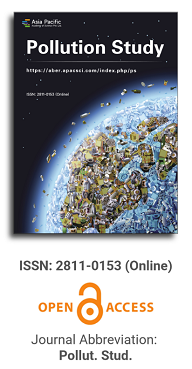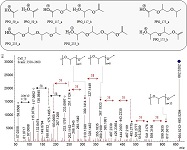
Asia Pacific Academy of Science Pte. Ltd. (APACSCI) specializes in international journal publishing. APACSCI adopts the open access publishing model and provides an important communication bridge for academic groups whose interest fields include engineering, technology, medicine, computer, mathematics, agriculture and forestry, and environment.

The (partial) replacement of synthetic polymers with bioplastics is due to increased production of conventional packaging plastics causing for severe environmental pollution with plastics waste. The bioplastics, however, represent complex mixtures of known and unknown (bio)polymers, fillers, plasticizers, stabilizers, flame retardant, pigments, antioxidants, hydrophobic polymers such as poly(lactic acid), polyethylene, polyesters, glycol, or poly(butylene succinate), and little is known of their chemical safety for both the environment and the human health. Polymerization reactions of bioplastics can produce no intentionally added chemicals to the bulk material, which could be toxic, as well. When polymers are used to food packing, then the latter chemicals could also migrate from the polymer to food. This fact compromises the safety for consumers, as well. The scarce data on chemical safety of bioplastics makes a gap in knowledge of their toxicity to humans and environment. Thus, development of exact analytical protocols for determining chemicals of bioplastics in environmental and food samples as well as packing polymers can only provide warrant for reliable conclusive evidence of their safety for both the human health and the environment. The task is compulsory according to legislation Directives valid to environmental protection, food control, and assessment of the risk to human health. The quantitative and structural determination of analytes is primary research task of analysis of polymers. The methods of mass spectrometry are fruitfully used for these purposes. Methodological development of exact analytical mass spectrometric tools for reliable structural analysis of bioplastics only guarantees their safety, efficacy, and quality to both humans and environment. This study, first, highlights innovative stochastic dynamics equations processing exactly mass spectrometric measurands and, thus, producing exact analyte quantification and 3D molecular and electronic structural analyses. There are determined synthetic polymers such as poly(ethylenglycol), poly(propylene glycol), and polyisoprene as well as biopolymers in bags for foodstuffs made from renewable cellulose and starch, and containing, in total within the 20,416–17,495 chemicals per sample of the composite biopolymers. Advantages of complementary employment in mass spectrometric methods and Fourier transform infrared spectroscopy is highlighted. The study utilizes ultra-high resolution electrospray ionization mass spectrometric and Fourier transform infrared spectroscopic data on biodegradable plastics bags for foodstuffs; high accuracy quantum chemical static methods, molecular dynamics; and chemometrics. There is achieved method performance |r| = 0.99981 determining poly(propylene glycol) in bag for foodstuff containing 20,416 species and using stochastic dynamics mass spectrometric formulas. The results highlight their great capability and applicability to the analytical science as well as relevance to both the fundamental research and to the industry.
Investigation into the enhancement of microbial remediation of petroleum-contaminated soil through chemical oxidation techniques
Vol 3, Issue 1, 2022
Download PDF
Abstract
This research utilized a bioreactor approach for the remediation of petroleum-contaminated soil, enhancing the process with chemical oxidation to investigate its efficacy. Additionally, the study employed the BIOLOG ECO board and high-throughput sequencing techniques to delve into the mechanisms behind the microbial community’s response. The findings indicated that after 240 days of bioremediation, the treatments involving standard bioremediation (NP) and bioremediation enhanced with oxidants (NP_O) reduced the soil’s total petroleum hydrocarbons from an initial 30,649 mg·g−1 to 5889 mg·g−1 and 2351 mg·g−1, respectively. The soil concentration of petroleum hydrocarbons following oxidation-enhanced bioremediation was found to be below the national risk control threshold (GB 36600-2018). Further analysis using BIOLOG ECO micropore tests and high-throughput sequencing revealed that microbial activity in the oxidant-treated soil was promptly rejuvenated. The study identified potential bacterial markers for petroleum hydrocarbon degradation in the treatment with chemical oxidation-enhanced bioremediation, including Genus Microbacterium, paracoccus, pseudomonas, stenotrophomonas, and Porticoccaceae_C1.B045.
Keywords
References
- Hoang SA, Lamb D, Seshadri B, et al. Rhizoremediation as a green technology for the remediation of petroleum hydrocarbon-contaminated soils. Journal of Hazardous Materials. 2021; 401: 123282. doi: 10.1016/j.jhazmat.2020.123282
- Fodelianakis S, Antoniou E, Mapelli F, et al. Allochthonous bioaugmentation in ex situ treatment of crude oil-polluted sediments in the presence of an effective degrading indigenous microbiome. Journal of Hazardous Materials. 2015; 287: 78-86. doi: 10.1016/j.jhazmat.2015.01.038
- Ossai IC, Ahmed A, Hassan A, et al. Remediation of soil and water contaminated with petroleum hydrocarbon: A review. Environmental Technology & Innovation. 2020; 17: 100526. doi: 10.1016/j.eti.2019.100526
- Zhen L, Hu T, Lv R, et al. Succession of microbial communities and synergetic effects during bioremediation of petroleum hydrocarbon-contaminated soil enhanced by chemical oxidation. Journal of Hazardous Materials. 2021; 410: 124869. doi: 10.1016/j.jhazmat.2020.124869
- Liao X, Wu Z, Li Y, et al. Effect of various chemical oxidation reagents on soil indigenous microbial diversity in remediation of soil contaminated by PAHs. Chemosphere. 2019; 226: 483-491. doi: 10.1016/j.chemosphere.2019.03.126
- Bajagain R, Park Y, Jeong SW. Feasibility of oxidation-biodegradation serial foam spraying for total petroleum hydrocarbon removal without soil disturbance. Science of The Total Environment. 2018; 626: 1236-1242. doi: 10.1016/j.scitotenv.2018.01.212
- Mora VC, Morelli IS, Rosso JA. Co-treatment of an oily sludge and aged contaminated soil: permanganate oxidation followed by bioremediation. Journal of Environmental Management. 2020; 261: 110169. doi: 10.1016/j.jenvman.2020.110169
- Xu J, Kong F, Song S, et al. Effect of Fenton pre-oxidation on mobilization of nutrients and efficient subsequent bioremediation of crude oil-contaminated soil. Chemosphere. 2017; 180: 1-10. doi: 10.1016/j.chemosphere.2017.03.087
- Zhou Y, Xiang Y, He Y, et al. Applications and factors influencing of the persulfate-based advanced oxidation processes for the remediation of groundwater and soil contaminated with organic compounds. Journal of Hazardous Materials. 2018; 359: 396-407. doi: 10.1016/j.jhazmat.2018.07.083
- Luo J, Zhao Y, Liao X, et al Combined effect of chemical preoxidation and bioaugmentation on phenanthrene degradation in soil. Journal of environmental engineering. 2019; 13(10): 2521-2529.
- Lu M, Zhang Z, Qiao W, et al. Removal of residual contaminants in petroleum-contaminated soil by Fenton-like oxidation. Journal of Hazardous Materials. 2010; 179(1-3): 604-611. doi: 10.1016/j.jhazmat.2010.03.046
- Zhang B, Guo Y, Huo J, et al. Combining chemical oxidation and bioremediation for petroleum polluted soil remediation by BC-nZVI activated persulfate. Chemical Engineering Journal. 2020; 382: 123055. doi: 10.1016/j.cej.2019.123055
- Lu M, Zhang Z, Qiao W, et al. Remediation of petroleum-contaminated soil after composting by sequential treatment with Fenton-like oxidation and biodegradation. Bioresource Technology. 2010; 101(7): 2106-2113. doi: 10.1016/j.biortech.2009.11.002
- Shahi A, Aydin S, Ince B, et al. Evaluation of microbial population and functional genes during the bioremediation of petroleum-contaminated soil as an effective monitoring approach. Ecotoxicology and Environmental Safety. 2016; 125: 153-160. doi: 10.1016/j.ecoenv.2015.11.029
- Hou J, Liu W, Wang B, et al. PGPR enhanced phytoremediation of petroleum contaminated soil and rhizosphere microbial community response. Chemosphere. 2015; 138: 592-598. doi: 10.1016/j.chemosphere.2015.07.025
- Bai X, Nie M, Diwu Z, et al. Enhanced degradation and mineralization of phenol by combining two highly efficient strains with divergent ring-cleavage pathways. Journal of Water Process Engineering. 2021; 39: 101743. doi: 10.1016/j.jwpe.2020.101743
- Xu Y, Wu M, Wang L, et al Changes and influencing factors of microbial population in oil contaminated soil in Northern Shaanxi oilfield area. China Environmental Science. 2021; 41(9): 4349-4359.
Supporting Agencies
Copyright (c) 2022 Kewei Xu, Lei Gu, Xuying Zheng, Biao Wang, Peng Guo

This work is licensed under a Creative Commons Attribution 4.0 International License.

This site is licensed under a Creative Commons Attribution 4.0 International License (CC BY 4.0).
.jpg)
Beijing University of Technology, China



